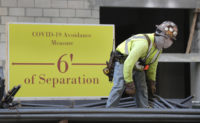If you think the election is tough to sort out, wait until Congress turns to fixing the economy. Donald Trump ran with a pledge of a quick bounce back from the pandemic-wounded economy, but Joseph Biden, the declared winner, may be able to manage only a long slog of a recovery. To get back faster, an infrastructure finance program should be among the first stimulus ideas taken up. Combined with public health initiatives that keep as much of the economy open as possible, this kind of stimulus could go a long way to relieve fears that hinder confidence and imperil a broad recovery.
Some categories of businesses—aviation, hotels, restaurants, amusement parks and higher education—and jobs are unlikely to quickly return to prior levels. We don’t know yet the future of office buildings or when the commuter transportation systems will pack in riders the way they did before the coronavirus pandemic.
The approach must combine virus spread control, state and local budget support, conventional infrastructure finance and money for clean energy research.
Construction has climbed part of the way out of the early 2020 pandemic hole, with multifamily residential architecture billings “roaring” back, reports the American Institute of Architects. But AIA also reports that billings “have stalled at firms with an institutional specialization” and remain soft in commercial/industrial work. Contractors strike a more worried note. After it had reviewed the U.S. government employment data, the Associated General Contractors on Oct. 20 said that most states had not recovered yet from the “severe pandemic-induced losses of construction jobs that occurred last spring.”
With the potential for gaps in future construction work created by canceled and postponed projects, a new administration must find its footing, and a vaccine must be successfully deployed. AGC believes another round of rescue loans is needed to head off widespread industry financial trouble and layoffs.
Taxes should be put on a back burner for now. With the recent gains in the stock market, numerous analysts say that Wall Street has shown it is happy with the gridlock it anticipates between the likely President Biden and a possibly still Republican-controlled Senate. That means there’s little chance of the Democrats reversing the tax cuts passed in 2017.
To conquer fears that inhibit spending and investment, a comprehensive approach is needed that combines virus spread control, selective help filling historic gaps in state and local budgets and, in addition to an infrastructure finance program, support for alternative and clean energy research that will lead to the creation of new technologies and industries. Regardless of which party controls the Senate, a bigger investment in clean energy research could be seen as an initial step toward the Democrats’ proposed Green New Deal. And maybe, just maybe, the infrastructure finance program is a way for both political parties, for the good of the country, to start doing more of what lawmakers are supposed to do—legislating in a bipartisan manner.





